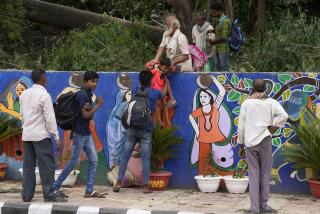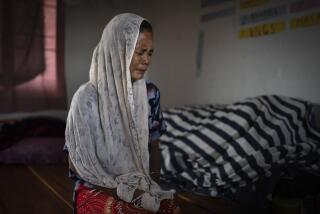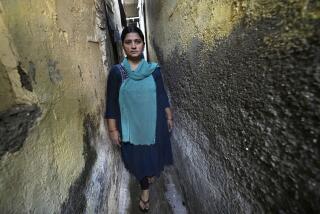National Agenda : Taking the Pulse of India’s Villages : The nation’s rural settlements contain more than 10% of the world’s people. Change comes slowly, but it comes.
- Share via
SURATGARH, India — Rameshwar Dayal Sharma is a big man in Suratgarh. The 72-year-old member of the priestly Brahmin caste has the village’s only refrigerator.
But it is not much use to the retired schoolteacher and his family. The blue Kelvinator, carefully draped with a cloth, sits in a room on the roof of his home. It is not plugged in. This remote village in the arid desert state of Rajasthan got electricity only four years ago, and the erratic, feeble power flow can’t keep a big appliance like a refrigerator running.
But Sharma, ailing and filmy-eyed, would rather talk about the big picture.
“Earlier, people were living here in simply miserable conditions,” the old Brahmin told a visitor as he rested on his bed. “Now they’re happier and more prosperous. They eat well. The poverty that 15 years ago was here is gone.”
Misery, want and ignorance remain the rule for countless millions of India’s citizens. In India’s poorest state, Bihar, inhabitants of some villages do not even know what country they live in.
But in most of the country’s 576,000 rural villages, changes are afoot.
“India lives in its villages,” independence leader Mohandas K. Gandhi said. Today, India is doing better than ever in the tiny dots across the map that are home to more than 660 million people--more than 10% of the human race.
This evolution is painfully slow and is often measured in minute events such as a villager’s purchase of a cake of soap or his newfound ability to write a letter to the local newspaper. But change, nonetheless, is occurring.
Five years ago, said Sumit Roy, head of the village marketing unit of Lintas, an Indian advertising agency, he felt the stirrings of a “rural middle-class boom.” These days, market surveys indicate that more than 75% of the bicycles and portable radios sold in India, and more than 60% of the table fans, sewing machines, bath soap and wristwatches are bought by the rural population. In fact, its total income available for spending on consumer goods--from toothpaste to motor scooters--is now estimated at more than $8 billion a year.
Prime Minister P.V. Narasimha Rao, himself a native of a village in the state of Andhra Pradesh, credits his government’s nearly 4-year-old economic reforms for improvements in India’s hinterlands.
But analysts say a much broader spectrum of factors is responsible: the expansion of scientific farming methods, the use of fertilizers, tractors and hybrid seeds, and the rains of seven successive good monsoon seasons.
“It’s true there’s never been more prosperity, but it’s as a result of their [villagers’] own efforts,” contends Ratan Katyani, a social activist in northeast Rajasthan. “There is absolutely no effect of the government’s policies.”
In a few years, the farm village of Suratgarh in the rocky, barren Aravali hills 140 miles southwest of New Delhi will celebrate its 300th anniversary.
*
For generations, people here have patiently endured fierce summer hot spells and torrential monsoons to wheedle a living from the soil, growing mustard, wheat, millet and lentils and raising cows, goats and water buffalo.
The earth and the weather remain by far the greatest influences on the lives of the 811 year-round residents of the village, as they do throughout rural India. But in 1991, a power cable was strung to Suratgarh, adding the village to the two-thirds of India’s rural settlements that have at least some electricity.
Then, two years later, a 1.2-mile ribbon of blacktop was laid down to link Suratgarh to a neighboring village and, ultimately, to the market town of Thana Gazi. Villagers hope that by the end of 1995 a telephone will be installed.
With so much progress so rapidly, Suratgarh is enjoying a boomlet whose bounty trickles down to many of the poorest.
“There’s a constant increase in income,” said Bewa Ram, a 50-year-old cobbler who crouched in his doorway, cutting slipper parts from a sheet of leather. “You can eat better food than before.”
These days, most people in Suratgarh are experiencing what for the Indian countryside is remarkable prosperity. Collectively, they possess a used tractor, one motor vehicle (an Indian-made Jeep), four motor scooters, two stoves that use bottled gas and a dozen black-and-white television sets.
Kedar Nath Sharma, a teacher, confidently predicts that life will get even better. He owns a hole-in-the-wall shop 10 feet square off Suratgarh’s dusty, unpaved main market place, selling razor blades, brown sugar, hot peppers, plastic combs, incense and other necessities.
*
Sharma, 40, no relation to his fellow Brahmin, the migrant teacher with the Kelvinator, used to stock only two brands of soap, Lifebuoy and OK.
But as more and more people from Suratgarh left to work in bigger villages or cities such as Jaipur, the Rajasthani capital, he had to adapt to growing tastes. The former villagers earned more money and were exposed to television and printed advertisements.
They were persuaded that other soaps, such as Nirma Beauty, would make their skin cleaner and softer or make them as desirable as film stars.
Now they demand new brands of soap, hair oils and other cosmetics that they have seen advertised.
As a result, Sharma reported happily, “I’m selling more--30% more--than three years ago.”
His income from the shop has climbed to 4,000 rupees, or more than $130, monthly.
He and other villagers also reject the idea that government policies have something to do with improvements in their lives.
Sumer Singh Rajawat, owner of the village’s sole tractor and probably its wealthiest resident with a concrete house and 12 acres of farmland, says, “The policies of Delhi have affected only big businessmen.
“Nothing has really gotten down to the small village yet,” says Rajawat, 52, whose streaming gray beard gives him the mien of a Hindu mystic.
*
Manohar Kant, the district tax collector and magistrate, the highest-ranking civil servant in the area around Suratgarh, concurs.
“If you go away from the turn in the road, you’ll find that change is very, very slow,” he says.
In the Alwar district of Rajasthan, Kant points out, 80% of the villages may be linked to the power grid--but only a third of the households in a typical village are connected. The others do without an electric light or fan.
Just 38% of the rural inhabitants of the district are literate.
By age 9, half of the pupils in the village schools have dropped out.
Meanwhile, the fast-growing rural population keeps increasing, by almost 3% a year.
Good times are a relative concept. Even now, only a quarter of the district’s rural population lives above the official poverty line of 11,000 rupees, or about $350, in annual income per household.
In Suratgarh, half of the males from 15 to 35 do not have a steady job, and most of the rest are underemployed. Four hundred people can neither read nor write.
*
For the improvements they can see--hand pumps, the road, the power line and a small dispensary--villagers give credit to their representative in the Rajasthani state Parliament, not faraway Delhi.
Their lawmaker, like the state government, is not from Prime Minister Rao’s Congress (I) Party, but from its chief rival, the Bharatiya Janata Party.
In the final analysis, the most momentous event of the 1990s in this village’s 137 households had nothing to do with government or politicians’ programs. It was the construction two years ago of a network of dams and water storage ponds by a local private charity, the Young India Union. Suddenly, Suratgarh had enough water in its tube wells to grow a hot-weather wheat crop.
Rajawat and some others tried last year, sweating through a hot season whose temperatures topped 120 degrees. Then, on April 6, 1994, a hailstorm flattened the crop.
Undaunted, Rajawat and other villagers are trying once again. Suratgarh is now ringed with a lush, high halo of grain, some stalks a restful green, the others already golden and heavy with ripe ears of wheat. The harvest, performed by hand with sickles, has already begun.
Even as the replenished water table opened up new money-making possibilities for Suratgarh’s 300 farmers and field laborers, another social mini-revolution has been freeing them and their neighbors from utter dependence on agriculture.
The new road--and the simultaneous spread of education--has made villagers more employable and given them easier access to jobs in other villages, even in other Indian states.
In Punjab in northern India, six months’ toil in the fields or brick kilns can net a villager the equivalent of $225. For the Raigars, leather workers who belong to the bottom of the Hindu social ladder, it is a bonanza with no equivalent at home.
In mid-April this year, no less than a third of the Raigar men of Suratgarh were away in Punjab performing seasonal labor.
Some poor villagers can now stay in their stone-and-mud hovels and make some money by weaving carpets on looms sent out by entrepreneurs from Jaipur.
That is the choice of Ram Sarup, 30, who works side by side with his wife, Murthi, 25, outside the door to their modest home.
For a day of back-killing labor on the loom, they earn a total of $1.60.
“It’s not much,” Ram Sarup says. “But at least we are not idle.”
*
Predictably, the new mobility, economic possibilities and wealth have been accompanied by new social ills. On the night of March 27, someone tiptoed up the steps of the temple in Suratgarh and stole an antique 15-inch Hindu statuette.
The villagers were crestfallen. For hundreds of miles around, people had known Suratgarh as the home of the blue stone-encrusted likeness of Lord Krishna, one of Hinduism’s most beloved gods.
With new roads making thieves as well as migrant workers more mobile, Kant, the district collector, predicts more crime.
Older folk in Suratgarh also believe that modern life has brought a degradation of people’s character and a greater obsession with material things and sex. Young people no longer respect their elders, complains Sadhu Ram, 68. “These days, nobody listens to nobody,” he grumbles between puffs on a hookah, the Indian water pipe.
But much in Suratgarh today would be perfectly recognizable to Ram’s grandparents, and even to his ancestors who, in 1702, were among those who chose to settle on a sun-scoured but fertile plain ringed by mountains.
*
Even today, villagers live in neighborhoods segregated by castes.
At the apex of the pecking order, there are 18 Brahmin families and Rajawat, the sole Rajput, a scion of the chivalrous warrior caste that once ruled much of Rajasthan.
At the bottom are the Raigars, no less than half of the village, who live on low-lying ground on Suratgarh’s south side in a jumble of small stone, adobe and concrete homes. Some of the old stigmas against them and other untouchables survive.
“When a Brahmin comes after me to use the hand pump, he washes the handle first,” says Kajor Singh, 35, a dhobi , or washerman.
As the intense heat and light of afternoon give way to the orangish warmth of dusk, Suratgarh’s heart beats to the ancient rhythms of the Indian countryside. The temple bell clangs, alerting men and women in the fields that their day of labor is ending.
Camels, buffalo and goats, shooed by boys or women wielding switches, trudge home along the unpaved and rock-studded dirt tracks that are Suratgarh’s streets. The animals, along with human arms and backs, are still the village’s chief power source.
Women, whose gender makes them the haulers of water, chat at the hand pumps before hoisting heavy metal urns or clay pots of water upon their heads for the trip home. At the sight of a male stranger, they shyly tug their veils over their faces.
At nightfall, squawking peacocks roost in the trees. The daytime clouds of flies are replaced by mosquitoes. The pungent smell of dried cow and buffalo manure, still burned as cooking fuel in most village households, permeates the air.
With such constants in mind, Suresh Pandit, a social activist and writer in the district center of Alwar, mocks the idea that the countryside’s new and modest prosperity is the same as progress.
“Girls can wear modern dress, like bell-bottom trousers,” Pandit maintains. “But they will still worship Gangur [a Hindu goddess] to ensure themselves a good husband.”
Sure enough, the two most marriageable girls in Suratgarh, Rajawat’s daughters Kiran, 17, and Sarla Kumari, 18, are in boarding school and dream of continuing their educations and forging careers. But if their future husbands and in-laws demand it, these articulate girls say, they will live shut up in the house after marriage.
“We do not feel that we are the equals of men,” pigtailed Kiran says.
*
But to say nothing has changed in Suratgarh is to ignore the obvious, as well as the opinion of most villagers.
The public school, which runs through the 8th grade, is now crowded with 200 pupils. Parents, Principal Kalyan Sahai Sharma says, have a “a greater awareness” of education’s importance.
Significantly, the lower castes are the keenest on pushing and helping their children through school, the educator says. That is because they know that Indian law reserves a percentage of school admissions and government jobs for them.
“My most meritorious pupils are from the Scheduled Castes [untouchables],” Sharma says.
Grainy television pictures received from Jaipur 50 miles away have made many of Suratgarh’s children more world-wise than their parents.
“When they see the picture of [Prime Minister] Narasimha Rao, they recognize him,” the school principal says. “That wouldn’t have been the case 35 years ago.”
Perhaps what is most novel in Suratgarh today is that, increasingly, villagers are coming to conceive of life as a set of possibilities, and not a given fixed by their caste or the narrow confines of life in a village in an out-of-the-way corner.
For 15 years, Mangelal, 50, has worked as a shoemaker, an occupation that in the traditional Hindu value system is considered particularly dirty and undignified because it entails handling the hides of dead animals. Because of villagers’ increased income, they now buy more shoes, and Mangelal’s monthly revenue has risen to $60.
This year, he is plowing more than three months of his earnings into the education of his 20-year-old son, who is studying for a bachelor’s degree in Jaipur.
For Mangelal, it is his bet that being born a Raigar in Suratgarh no longer condemns a person to a poor-paying, low-status place in society.
“My son should not do this shoe job,” Mangelal says gently, but with firmness.
(BEGIN TEXT OF INFOBOX / INFOGRAPHIC)
The Rural Gap About 74% of India’s nearly 920 million people live in rural areas. By several indexes, they are less well off than their urban couterparts. *
Percentage living below official poverty line. Urban: 20.1% Rural: 33.4% *
Literacy rate Urban: 73.0% Rural: 44.5% *
Death rate (per 1,000 people) Urban: 6.7 Rural: 10.4 *
Infant mortality rate (per 1,000 live births) Urban: 51 Rural: 86 *
Members of middle class* (in millions) Urban: 19.5 Rural: 8.5 * Note: Defined in one survey as monthly income of 3,500 to 10,000 rupees (about $113 to $324) Compiled by AMITABH SHARMA, New Delhi bureau Sources: 1991 Indian Government Census, Statistical Outline of India 1992-93; National Center for Applied Economic Research survey.
More to Read
Sign up for Essential California
The most important California stories and recommendations in your inbox every morning.
You may occasionally receive promotional content from the Los Angeles Times.













